Understanding Aboriginal and Torres Strait Islander Culture
VerifiedAdded on 2021/01/02
|11
|3518
|142
Homework Assignment
AI Summary
This document presents a series of lesson plans designed to educate students about the diverse cultures of Aboriginal and Torres Strait Islander peoples. The lesson plans cover various aspects of their societies, including cultural differences, their special connection to the land, language groups, family and kinship structures, and customary laws. Each lesson plan outlines specific learning outcomes, teaching activities, and assessment methods. The plans incorporate drama-based learning to engage students and facilitate understanding of complex cultural concepts. The resources needed, such as music systems and boards, are also mentioned. The goal is to foster a deeper appreciation for the historical and contemporary significance of Aboriginal and Torres Strait Islander cultures.
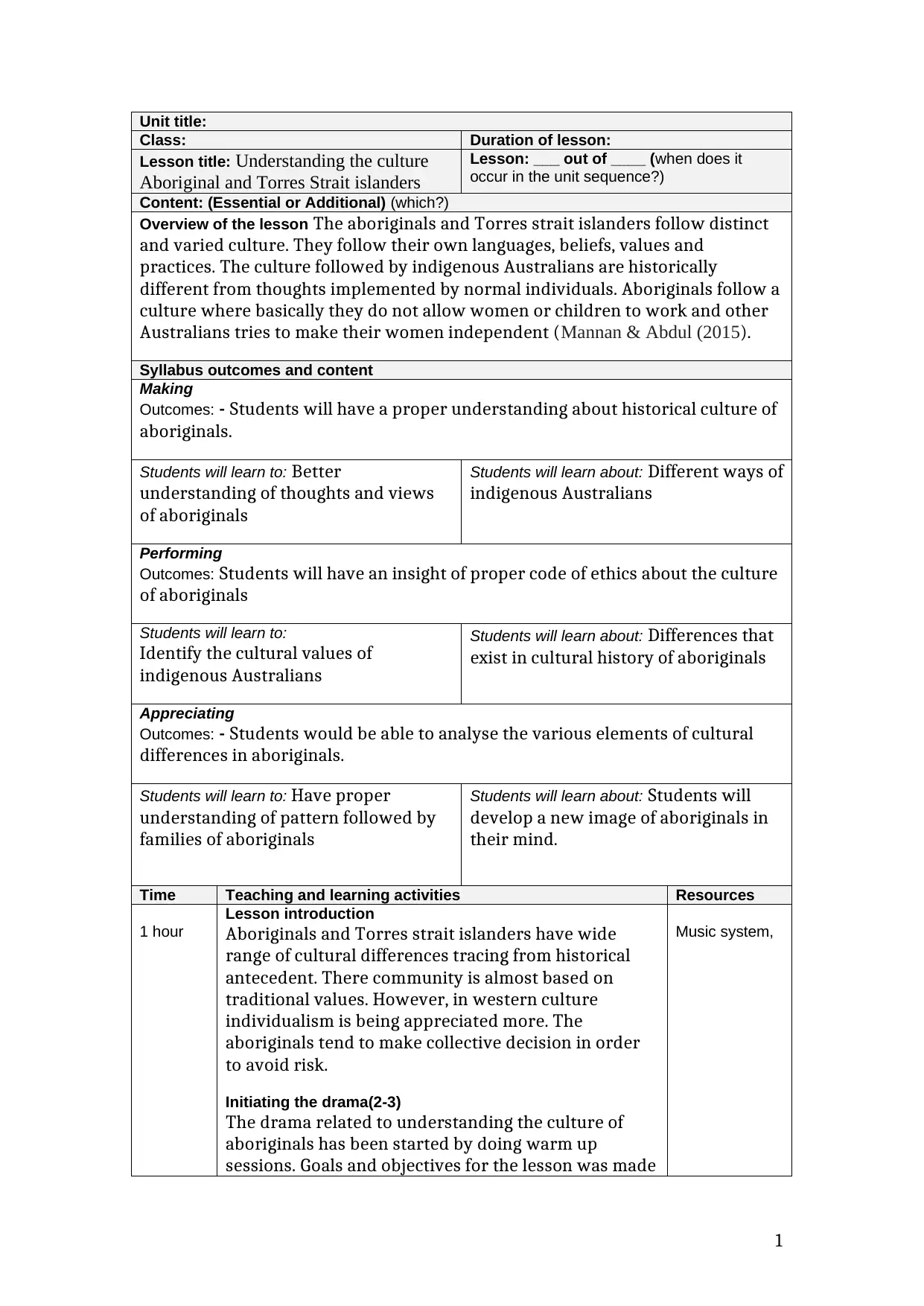
Unit title:
Class: Duration of lesson:
Lesson title: Understanding the culture
Aboriginal and Torres Strait islanders
Lesson: ___ out of ____ (when does it
occur in the unit sequence?)
Content: (Essential or Additional) (which?)
Overview of the lesson The aboriginals and Torres strait islanders follow distinct
and varied culture. They follow their own languages, beliefs, values and
practices. The culture followed by indigenous Australians are historically
different from thoughts implemented by normal individuals. Aboriginals follow a
culture where basically they do not allow women or children to work and other
Australians tries to make their women independent (Mannan & Abdul (2015).
Syllabus outcomes and content
Making
Outcomes: - Students will have a proper understanding about historical culture of
aboriginals.
Students will learn to: Better
understanding of thoughts and views
of aboriginals
Students will learn about: Different ways of
indigenous Australians
Performing
Outcomes: Students will have an insight of proper code of ethics about the culture
of aboriginals
Students will learn to:
Identify the cultural values of
indigenous Australians
Students will learn about: Differences that
exist in cultural history of aboriginals
Appreciating
Outcomes: - Students would be able to analyse the various elements of cultural
differences in aboriginals.
Students will learn to: Have proper
understanding of pattern followed by
families of aboriginals
Students will learn about: Students will
develop a new image of aboriginals in
their mind.
Time Teaching and learning activities Resources
1 hour
Lesson introduction
Aboriginals and Torres strait islanders have wide
range of cultural differences tracing from historical
antecedent. There community is almost based on
traditional values. However, in western culture
individualism is being appreciated more. The
aboriginals tend to make collective decision in order
to avoid risk.
Initiating the drama(2-3)
The drama related to understanding the culture of
aboriginals has been started by doing warm up
sessions. Goals and objectives for the lesson was made
Music system,
1
Class: Duration of lesson:
Lesson title: Understanding the culture
Aboriginal and Torres Strait islanders
Lesson: ___ out of ____ (when does it
occur in the unit sequence?)
Content: (Essential or Additional) (which?)
Overview of the lesson The aboriginals and Torres strait islanders follow distinct
and varied culture. They follow their own languages, beliefs, values and
practices. The culture followed by indigenous Australians are historically
different from thoughts implemented by normal individuals. Aboriginals follow a
culture where basically they do not allow women or children to work and other
Australians tries to make their women independent (Mannan & Abdul (2015).
Syllabus outcomes and content
Making
Outcomes: - Students will have a proper understanding about historical culture of
aboriginals.
Students will learn to: Better
understanding of thoughts and views
of aboriginals
Students will learn about: Different ways of
indigenous Australians
Performing
Outcomes: Students will have an insight of proper code of ethics about the culture
of aboriginals
Students will learn to:
Identify the cultural values of
indigenous Australians
Students will learn about: Differences that
exist in cultural history of aboriginals
Appreciating
Outcomes: - Students would be able to analyse the various elements of cultural
differences in aboriginals.
Students will learn to: Have proper
understanding of pattern followed by
families of aboriginals
Students will learn about: Students will
develop a new image of aboriginals in
their mind.
Time Teaching and learning activities Resources
1 hour
Lesson introduction
Aboriginals and Torres strait islanders have wide
range of cultural differences tracing from historical
antecedent. There community is almost based on
traditional values. However, in western culture
individualism is being appreciated more. The
aboriginals tend to make collective decision in order
to avoid risk.
Initiating the drama(2-3)
The drama related to understanding the culture of
aboriginals has been started by doing warm up
sessions. Goals and objectives for the lesson was made
Music system,
1
Paraphrase This Document
Need a fresh take? Get an instant paraphrase of this document with our AI Paraphraser
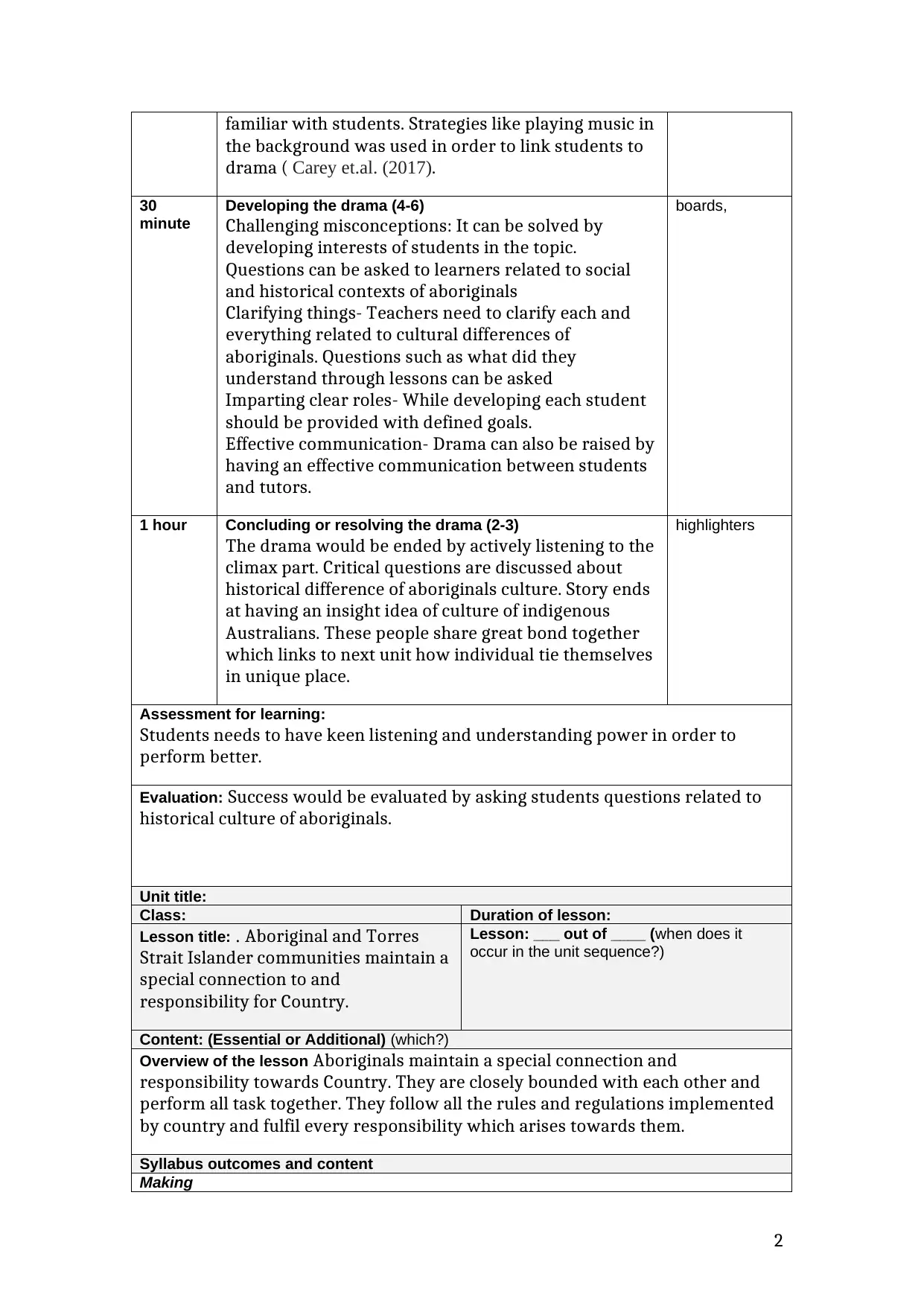
familiar with students. Strategies like playing music in
the background was used in order to link students to
drama ( Carey et.al. (2017).
30
minute
Developing the drama (4-6)
Challenging misconceptions: It can be solved by
developing interests of students in the topic.
Questions can be asked to learners related to social
and historical contexts of aboriginals
Clarifying things- Teachers need to clarify each and
everything related to cultural differences of
aboriginals. Questions such as what did they
understand through lessons can be asked
Imparting clear roles- While developing each student
should be provided with defined goals.
Effective communication- Drama can also be raised by
having an effective communication between students
and tutors.
boards,
1 hour Concluding or resolving the drama (2-3)
The drama would be ended by actively listening to the
climax part. Critical questions are discussed about
historical difference of aboriginals culture. Story ends
at having an insight idea of culture of indigenous
Australians. These people share great bond together
which links to next unit how individual tie themselves
in unique place.
highlighters
Assessment for learning:
Students needs to have keen listening and understanding power in order to
perform better.
Evaluation: Success would be evaluated by asking students questions related to
historical culture of aboriginals.
Unit title:
Class: Duration of lesson:
Lesson title: . Aboriginal and Torres
Strait Islander communities maintain a
special connection to and
responsibility for Country.
Lesson: ___ out of ____ (when does it
occur in the unit sequence?)
Content: (Essential or Additional) (which?)
Overview of the lesson Aboriginals maintain a special connection and
responsibility towards Country. They are closely bounded with each other and
perform all task together. They follow all the rules and regulations implemented
by country and fulfil every responsibility which arises towards them.
Syllabus outcomes and content
Making
2
the background was used in order to link students to
drama ( Carey et.al. (2017).
30
minute
Developing the drama (4-6)
Challenging misconceptions: It can be solved by
developing interests of students in the topic.
Questions can be asked to learners related to social
and historical contexts of aboriginals
Clarifying things- Teachers need to clarify each and
everything related to cultural differences of
aboriginals. Questions such as what did they
understand through lessons can be asked
Imparting clear roles- While developing each student
should be provided with defined goals.
Effective communication- Drama can also be raised by
having an effective communication between students
and tutors.
boards,
1 hour Concluding or resolving the drama (2-3)
The drama would be ended by actively listening to the
climax part. Critical questions are discussed about
historical difference of aboriginals culture. Story ends
at having an insight idea of culture of indigenous
Australians. These people share great bond together
which links to next unit how individual tie themselves
in unique place.
highlighters
Assessment for learning:
Students needs to have keen listening and understanding power in order to
perform better.
Evaluation: Success would be evaluated by asking students questions related to
historical culture of aboriginals.
Unit title:
Class: Duration of lesson:
Lesson title: . Aboriginal and Torres
Strait Islander communities maintain a
special connection to and
responsibility for Country.
Lesson: ___ out of ____ (when does it
occur in the unit sequence?)
Content: (Essential or Additional) (which?)
Overview of the lesson Aboriginals maintain a special connection and
responsibility towards Country. They are closely bounded with each other and
perform all task together. They follow all the rules and regulations implemented
by country and fulfil every responsibility which arises towards them.
Syllabus outcomes and content
Making
2
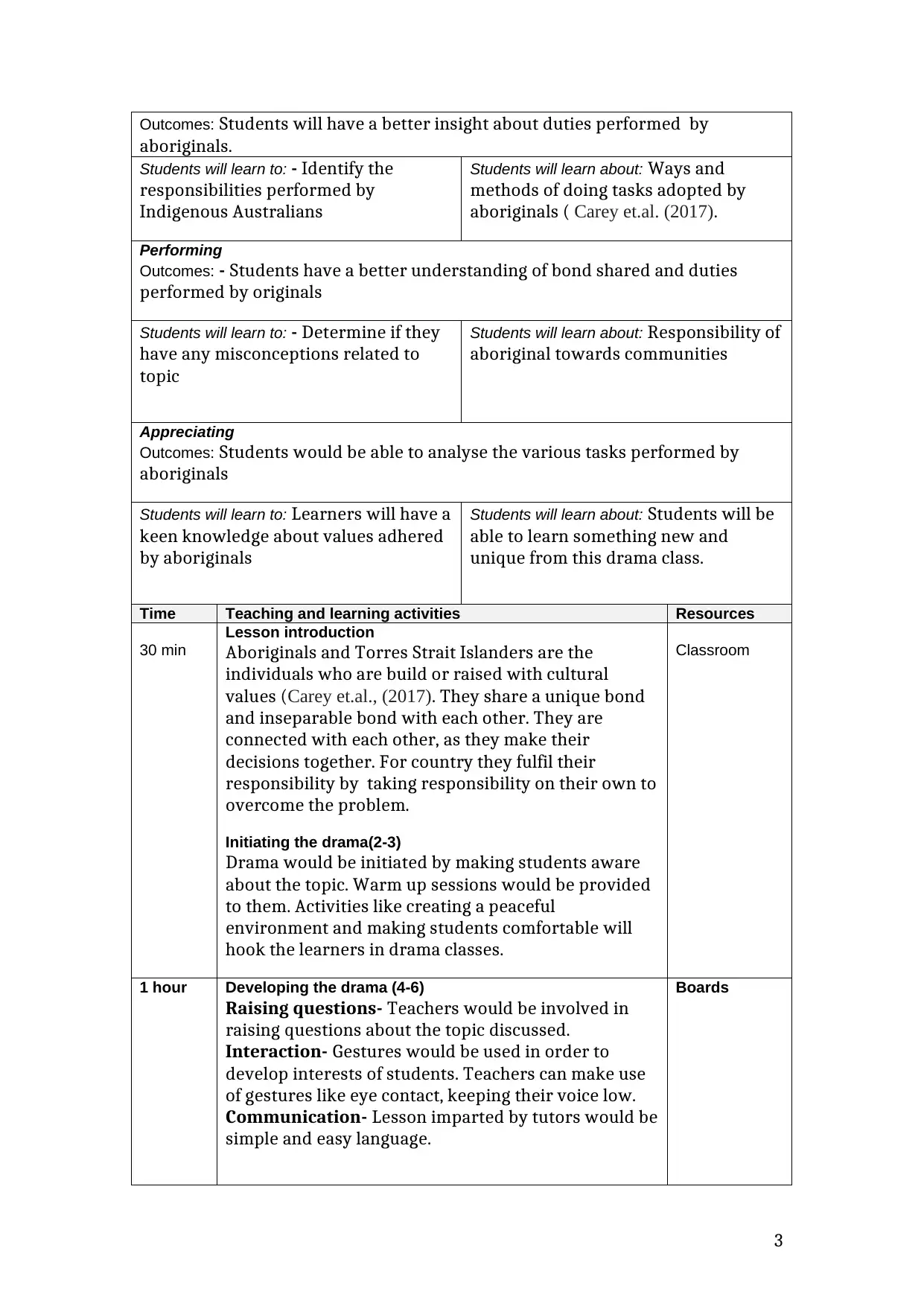
Outcomes: Students will have a better insight about duties performed by
aboriginals.
Students will learn to: - Identify the
responsibilities performed by
Indigenous Australians
Students will learn about: Ways and
methods of doing tasks adopted by
aboriginals ( Carey et.al. (2017).
Performing
Outcomes: - Students have a better understanding of bond shared and duties
performed by originals
Students will learn to: - Determine if they
have any misconceptions related to
topic
Students will learn about: Responsibility of
aboriginal towards communities
Appreciating
Outcomes: Students would be able to analyse the various tasks performed by
aboriginals
Students will learn to: Learners will have a
keen knowledge about values adhered
by aboriginals
Students will learn about: Students will be
able to learn something new and
unique from this drama class.
Time Teaching and learning activities Resources
30 min
Lesson introduction
Aboriginals and Torres Strait Islanders are the
individuals who are build or raised with cultural
values (Carey et.al., (2017). They share a unique bond
and inseparable bond with each other. They are
connected with each other, as they make their
decisions together. For country they fulfil their
responsibility by taking responsibility on their own to
overcome the problem.
Initiating the drama(2-3)
Drama would be initiated by making students aware
about the topic. Warm up sessions would be provided
to them. Activities like creating a peaceful
environment and making students comfortable will
hook the learners in drama classes.
Classroom
1 hour Developing the drama (4-6)
Raising questions- Teachers would be involved in
raising questions about the topic discussed.
Interaction- Gestures would be used in order to
develop interests of students. Teachers can make use
of gestures like eye contact, keeping their voice low.
Communication- Lesson imparted by tutors would be
simple and easy language.
Boards
3
aboriginals.
Students will learn to: - Identify the
responsibilities performed by
Indigenous Australians
Students will learn about: Ways and
methods of doing tasks adopted by
aboriginals ( Carey et.al. (2017).
Performing
Outcomes: - Students have a better understanding of bond shared and duties
performed by originals
Students will learn to: - Determine if they
have any misconceptions related to
topic
Students will learn about: Responsibility of
aboriginal towards communities
Appreciating
Outcomes: Students would be able to analyse the various tasks performed by
aboriginals
Students will learn to: Learners will have a
keen knowledge about values adhered
by aboriginals
Students will learn about: Students will be
able to learn something new and
unique from this drama class.
Time Teaching and learning activities Resources
30 min
Lesson introduction
Aboriginals and Torres Strait Islanders are the
individuals who are build or raised with cultural
values (Carey et.al., (2017). They share a unique bond
and inseparable bond with each other. They are
connected with each other, as they make their
decisions together. For country they fulfil their
responsibility by taking responsibility on their own to
overcome the problem.
Initiating the drama(2-3)
Drama would be initiated by making students aware
about the topic. Warm up sessions would be provided
to them. Activities like creating a peaceful
environment and making students comfortable will
hook the learners in drama classes.
Classroom
1 hour Developing the drama (4-6)
Raising questions- Teachers would be involved in
raising questions about the topic discussed.
Interaction- Gestures would be used in order to
develop interests of students. Teachers can make use
of gestures like eye contact, keeping their voice low.
Communication- Lesson imparted by tutors would be
simple and easy language.
Boards
3
⊘ This is a preview!⊘
Do you want full access?
Subscribe today to unlock all pages.

Trusted by 1+ million students worldwide
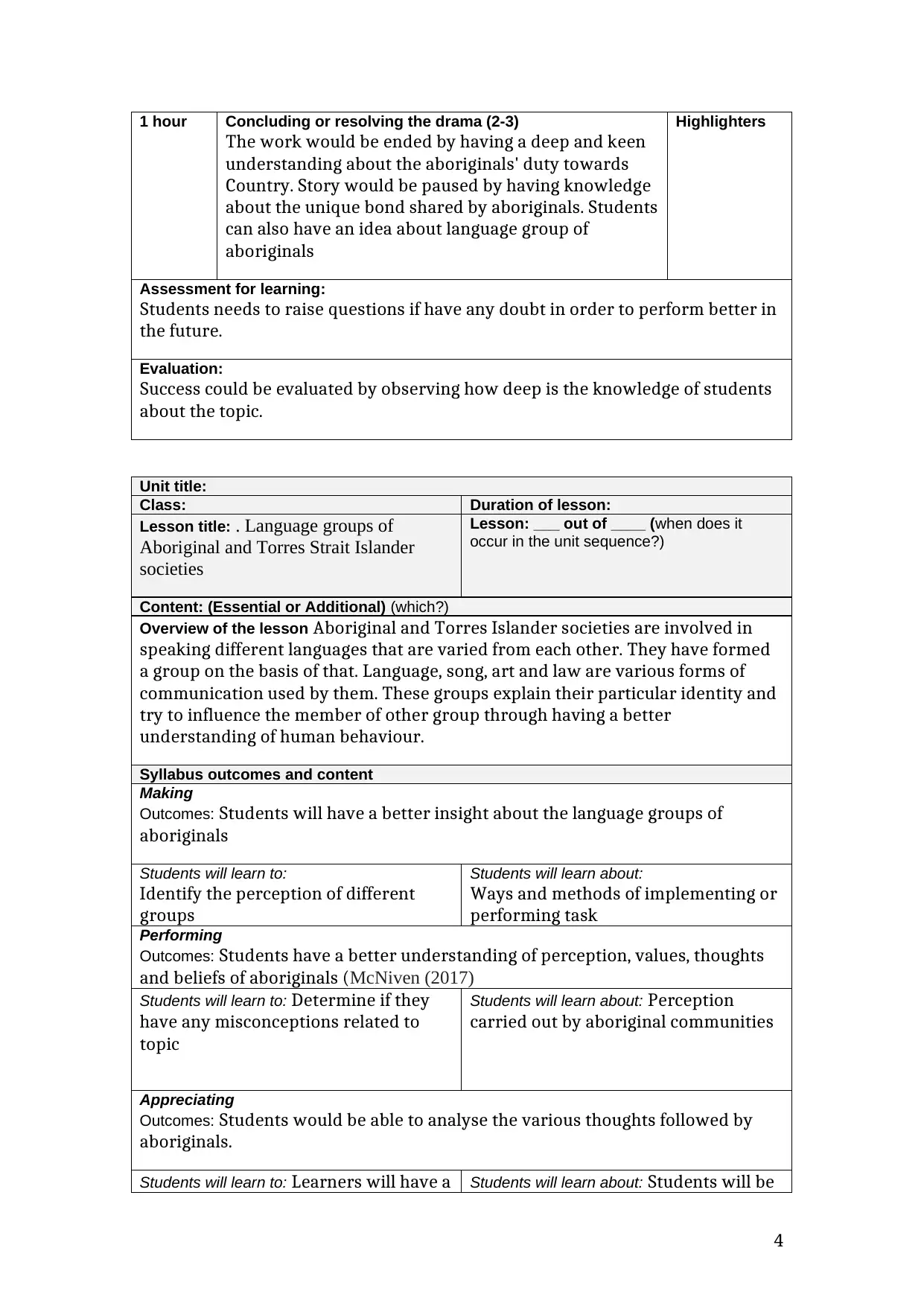
1 hour Concluding or resolving the drama (2-3)
The work would be ended by having a deep and keen
understanding about the aboriginals' duty towards
Country. Story would be paused by having knowledge
about the unique bond shared by aboriginals. Students
can also have an idea about language group of
aboriginals
Highlighters
Assessment for learning:
Students needs to raise questions if have any doubt in order to perform better in
the future.
Evaluation:
Success could be evaluated by observing how deep is the knowledge of students
about the topic.
Unit title:
Class: Duration of lesson:
Lesson title: . Language groups of
Aboriginal and Torres Strait Islander
societies
Lesson: ___ out of ____ (when does it
occur in the unit sequence?)
Content: (Essential or Additional) (which?)
Overview of the lesson Aboriginal and Torres Islander societies are involved in
speaking different languages that are varied from each other. They have formed
a group on the basis of that. Language, song, art and law are various forms of
communication used by them. These groups explain their particular identity and
try to influence the member of other group through having a better
understanding of human behaviour.
Syllabus outcomes and content
Making
Outcomes: Students will have a better insight about the language groups of
aboriginals
Students will learn to:
Identify the perception of different
groups
Students will learn about:
Ways and methods of implementing or
performing task
Performing
Outcomes: Students have a better understanding of perception, values, thoughts
and beliefs of aboriginals (McNiven (2017)
Students will learn to: Determine if they
have any misconceptions related to
topic
Students will learn about: Perception
carried out by aboriginal communities
Appreciating
Outcomes: Students would be able to analyse the various thoughts followed by
aboriginals.
Students will learn to: Learners will have a Students will learn about: Students will be
4
The work would be ended by having a deep and keen
understanding about the aboriginals' duty towards
Country. Story would be paused by having knowledge
about the unique bond shared by aboriginals. Students
can also have an idea about language group of
aboriginals
Highlighters
Assessment for learning:
Students needs to raise questions if have any doubt in order to perform better in
the future.
Evaluation:
Success could be evaluated by observing how deep is the knowledge of students
about the topic.
Unit title:
Class: Duration of lesson:
Lesson title: . Language groups of
Aboriginal and Torres Strait Islander
societies
Lesson: ___ out of ____ (when does it
occur in the unit sequence?)
Content: (Essential or Additional) (which?)
Overview of the lesson Aboriginal and Torres Islander societies are involved in
speaking different languages that are varied from each other. They have formed
a group on the basis of that. Language, song, art and law are various forms of
communication used by them. These groups explain their particular identity and
try to influence the member of other group through having a better
understanding of human behaviour.
Syllabus outcomes and content
Making
Outcomes: Students will have a better insight about the language groups of
aboriginals
Students will learn to:
Identify the perception of different
groups
Students will learn about:
Ways and methods of implementing or
performing task
Performing
Outcomes: Students have a better understanding of perception, values, thoughts
and beliefs of aboriginals (McNiven (2017)
Students will learn to: Determine if they
have any misconceptions related to
topic
Students will learn about: Perception
carried out by aboriginal communities
Appreciating
Outcomes: Students would be able to analyse the various thoughts followed by
aboriginals.
Students will learn to: Learners will have a Students will learn about: Students will be
4
Paraphrase This Document
Need a fresh take? Get an instant paraphrase of this document with our AI Paraphraser
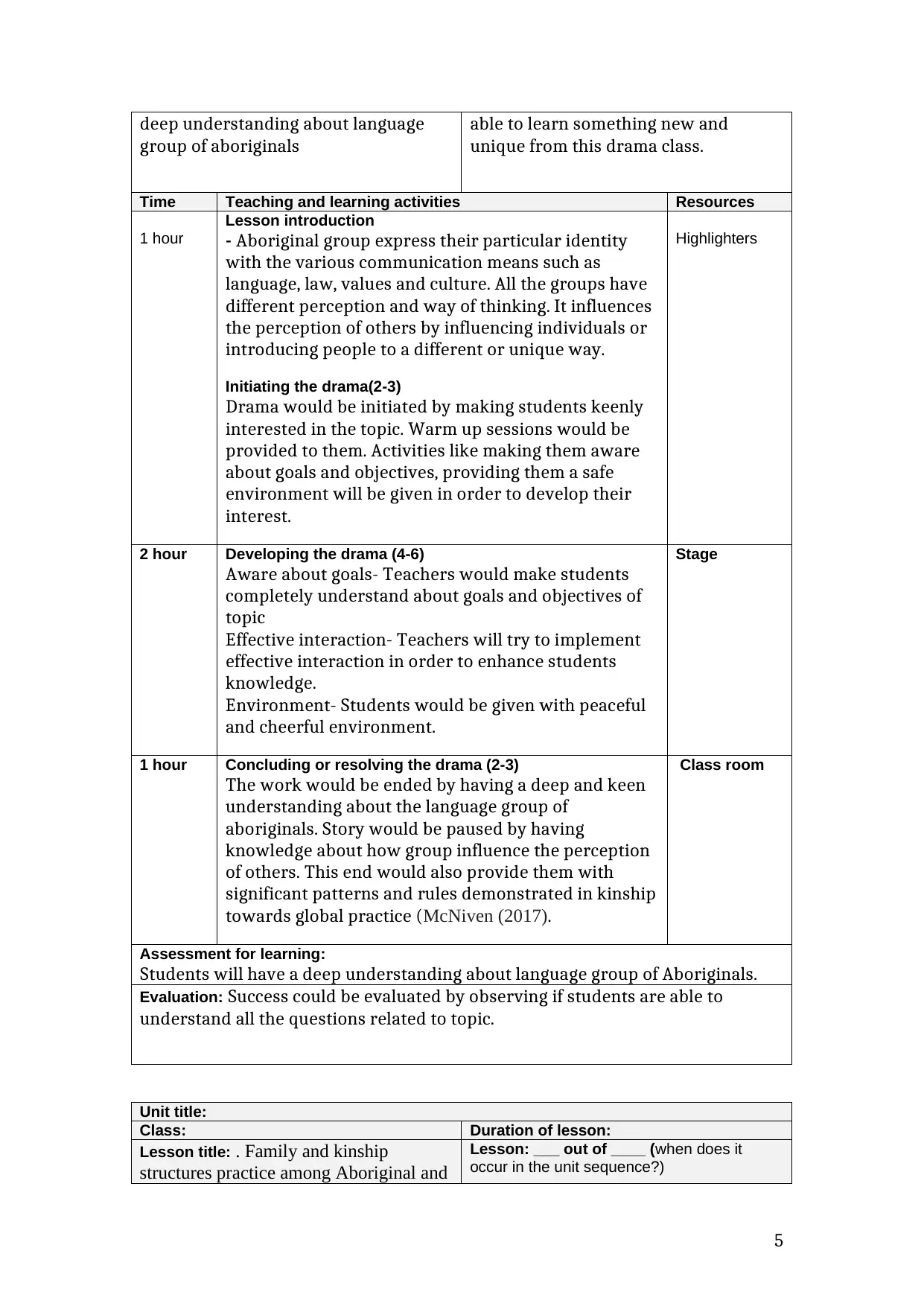
deep understanding about language
group of aboriginals
able to learn something new and
unique from this drama class.
Time Teaching and learning activities Resources
1 hour
Lesson introduction
- Aboriginal group express their particular identity
with the various communication means such as
language, law, values and culture. All the groups have
different perception and way of thinking. It influences
the perception of others by influencing individuals or
introducing people to a different or unique way.
Initiating the drama(2-3)
Drama would be initiated by making students keenly
interested in the topic. Warm up sessions would be
provided to them. Activities like making them aware
about goals and objectives, providing them a safe
environment will be given in order to develop their
interest.
Highlighters
2 hour Developing the drama (4-6)
Aware about goals- Teachers would make students
completely understand about goals and objectives of
topic
Effective interaction- Teachers will try to implement
effective interaction in order to enhance students
knowledge.
Environment- Students would be given with peaceful
and cheerful environment.
Stage
1 hour Concluding or resolving the drama (2-3)
The work would be ended by having a deep and keen
understanding about the language group of
aboriginals. Story would be paused by having
knowledge about how group influence the perception
of others. This end would also provide them with
significant patterns and rules demonstrated in kinship
towards global practice (McNiven (2017).
Class room
Assessment for learning:
Students will have a deep understanding about language group of Aboriginals.
Evaluation: Success could be evaluated by observing if students are able to
understand all the questions related to topic.
Unit title:
Class: Duration of lesson:
Lesson title: . Family and kinship
structures practice among Aboriginal and
Lesson: ___ out of ____ (when does it
occur in the unit sequence?)
5
group of aboriginals
able to learn something new and
unique from this drama class.
Time Teaching and learning activities Resources
1 hour
Lesson introduction
- Aboriginal group express their particular identity
with the various communication means such as
language, law, values and culture. All the groups have
different perception and way of thinking. It influences
the perception of others by influencing individuals or
introducing people to a different or unique way.
Initiating the drama(2-3)
Drama would be initiated by making students keenly
interested in the topic. Warm up sessions would be
provided to them. Activities like making them aware
about goals and objectives, providing them a safe
environment will be given in order to develop their
interest.
Highlighters
2 hour Developing the drama (4-6)
Aware about goals- Teachers would make students
completely understand about goals and objectives of
topic
Effective interaction- Teachers will try to implement
effective interaction in order to enhance students
knowledge.
Environment- Students would be given with peaceful
and cheerful environment.
Stage
1 hour Concluding or resolving the drama (2-3)
The work would be ended by having a deep and keen
understanding about the language group of
aboriginals. Story would be paused by having
knowledge about how group influence the perception
of others. This end would also provide them with
significant patterns and rules demonstrated in kinship
towards global practice (McNiven (2017).
Class room
Assessment for learning:
Students will have a deep understanding about language group of Aboriginals.
Evaluation: Success could be evaluated by observing if students are able to
understand all the questions related to topic.
Unit title:
Class: Duration of lesson:
Lesson title: . Family and kinship
structures practice among Aboriginal and
Lesson: ___ out of ____ (when does it
occur in the unit sequence?)
5
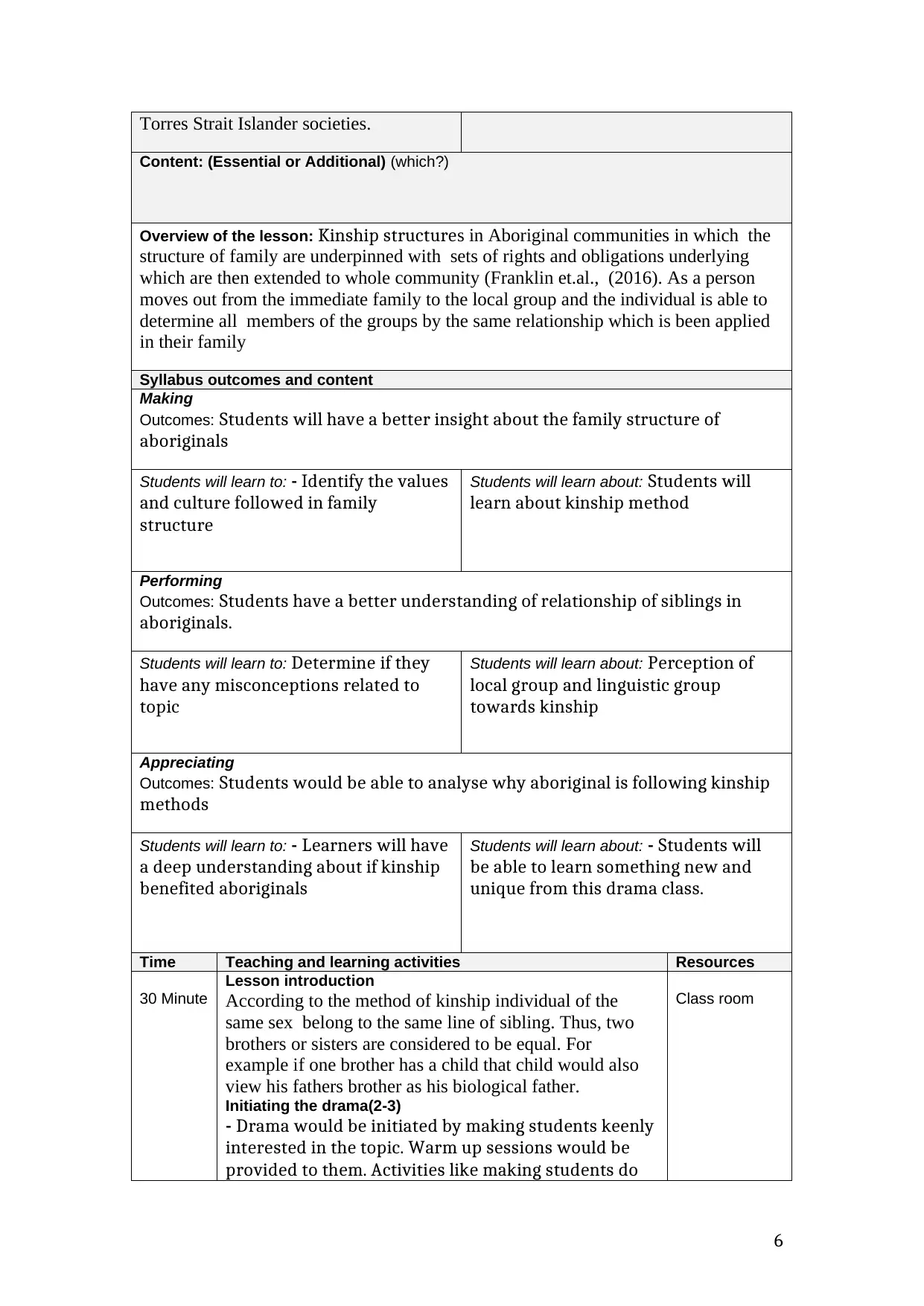
Torres Strait Islander societies.
Content: (Essential or Additional) (which?)
Overview of the lesson: Kinship structures in Aboriginal communities in which the
structure of family are underpinned with sets of rights and obligations underlying
which are then extended to whole community (Franklin et.al., (2016). As a person
moves out from the immediate family to the local group and the individual is able to
determine all members of the groups by the same relationship which is been applied
in their family
Syllabus outcomes and content
Making
Outcomes: Students will have a better insight about the family structure of
aboriginals
Students will learn to: - Identify the values
and culture followed in family
structure
Students will learn about: Students will
learn about kinship method
Performing
Outcomes: Students have a better understanding of relationship of siblings in
aboriginals.
Students will learn to: Determine if they
have any misconceptions related to
topic
Students will learn about: Perception of
local group and linguistic group
towards kinship
Appreciating
Outcomes: Students would be able to analyse why aboriginal is following kinship
methods
Students will learn to: - Learners will have
a deep understanding about if kinship
benefited aboriginals
Students will learn about: - Students will
be able to learn something new and
unique from this drama class.
Time Teaching and learning activities Resources
30 Minute
Lesson introduction
According to the method of kinship individual of the
same sex belong to the same line of sibling. Thus, two
brothers or sisters are considered to be equal. For
example if one brother has a child that child would also
view his fathers brother as his biological father.
Initiating the drama(2-3)
- Drama would be initiated by making students keenly
interested in the topic. Warm up sessions would be
provided to them. Activities like making students do
Class room
6
Content: (Essential or Additional) (which?)
Overview of the lesson: Kinship structures in Aboriginal communities in which the
structure of family are underpinned with sets of rights and obligations underlying
which are then extended to whole community (Franklin et.al., (2016). As a person
moves out from the immediate family to the local group and the individual is able to
determine all members of the groups by the same relationship which is been applied
in their family
Syllabus outcomes and content
Making
Outcomes: Students will have a better insight about the family structure of
aboriginals
Students will learn to: - Identify the values
and culture followed in family
structure
Students will learn about: Students will
learn about kinship method
Performing
Outcomes: Students have a better understanding of relationship of siblings in
aboriginals.
Students will learn to: Determine if they
have any misconceptions related to
topic
Students will learn about: Perception of
local group and linguistic group
towards kinship
Appreciating
Outcomes: Students would be able to analyse why aboriginal is following kinship
methods
Students will learn to: - Learners will have
a deep understanding about if kinship
benefited aboriginals
Students will learn about: - Students will
be able to learn something new and
unique from this drama class.
Time Teaching and learning activities Resources
30 Minute
Lesson introduction
According to the method of kinship individual of the
same sex belong to the same line of sibling. Thus, two
brothers or sisters are considered to be equal. For
example if one brother has a child that child would also
view his fathers brother as his biological father.
Initiating the drama(2-3)
- Drama would be initiated by making students keenly
interested in the topic. Warm up sessions would be
provided to them. Activities like making students do
Class room
6
⊘ This is a preview!⊘
Do you want full access?
Subscribe today to unlock all pages.

Trusted by 1+ million students worldwide
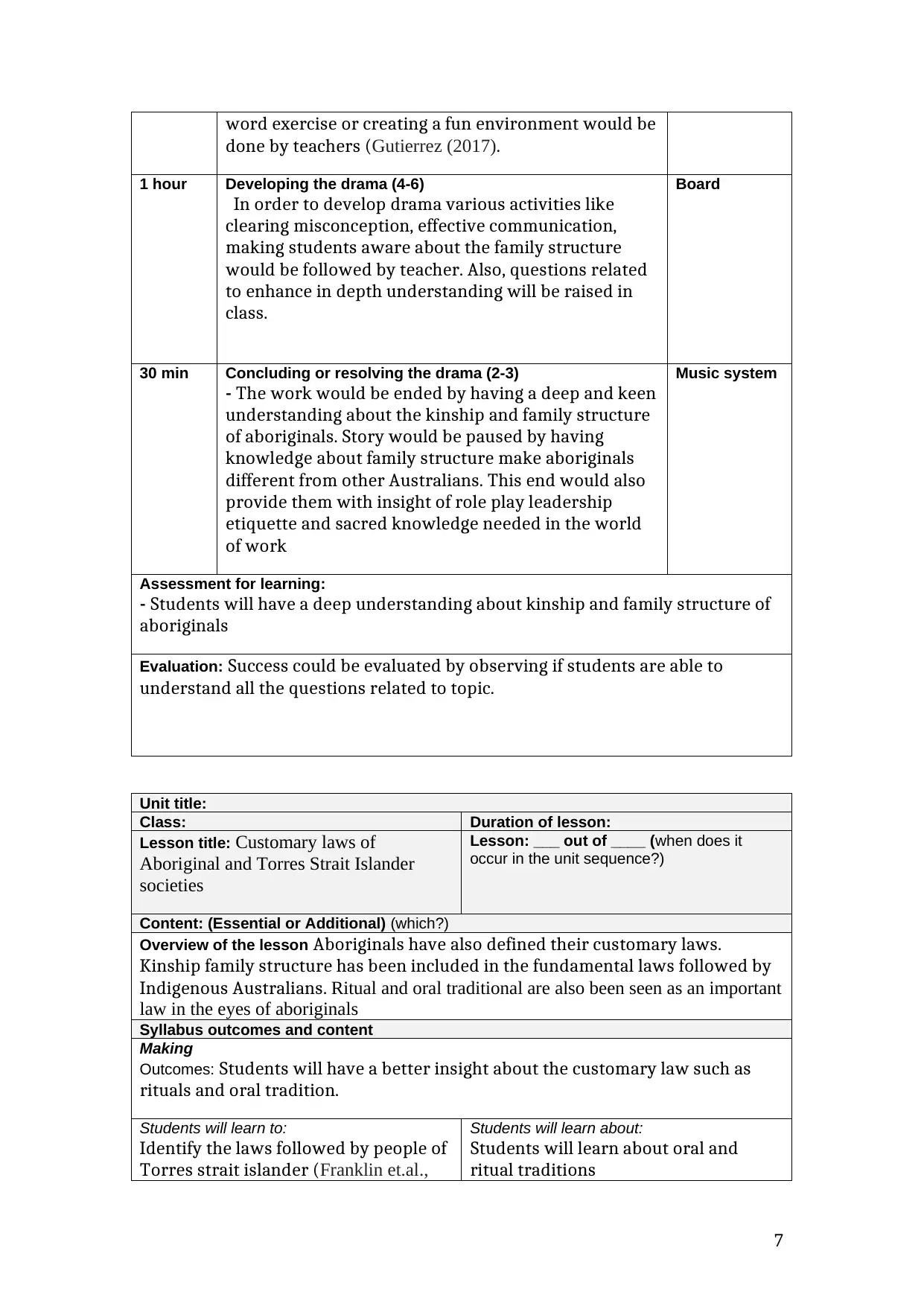
word exercise or creating a fun environment would be
done by teachers (Gutierrez (2017).
1 hour Developing the drama (4-6)
In order to develop drama various activities like
clearing misconception, effective communication,
making students aware about the family structure
would be followed by teacher. Also, questions related
to enhance in depth understanding will be raised in
class.
Board
30 min Concluding or resolving the drama (2-3)
- The work would be ended by having a deep and keen
understanding about the kinship and family structure
of aboriginals. Story would be paused by having
knowledge about family structure make aboriginals
different from other Australians. This end would also
provide them with insight of role play leadership
etiquette and sacred knowledge needed in the world
of work
Music system
Assessment for learning:
- Students will have a deep understanding about kinship and family structure of
aboriginals
Evaluation: Success could be evaluated by observing if students are able to
understand all the questions related to topic.
Unit title:
Class: Duration of lesson:
Lesson title: Customary laws of
Aboriginal and Torres Strait Islander
societies
Lesson: ___ out of ____ (when does it
occur in the unit sequence?)
Content: (Essential or Additional) (which?)
Overview of the lesson Aboriginals have also defined their customary laws.
Kinship family structure has been included in the fundamental laws followed by
Indigenous Australians. Ritual and oral traditional are also been seen as an important
law in the eyes of aboriginals
Syllabus outcomes and content
Making
Outcomes: Students will have a better insight about the customary law such as
rituals and oral tradition.
Students will learn to:
Identify the laws followed by people of
Torres strait islander (Franklin et.al.,
Students will learn about:
Students will learn about oral and
ritual traditions
7
done by teachers (Gutierrez (2017).
1 hour Developing the drama (4-6)
In order to develop drama various activities like
clearing misconception, effective communication,
making students aware about the family structure
would be followed by teacher. Also, questions related
to enhance in depth understanding will be raised in
class.
Board
30 min Concluding or resolving the drama (2-3)
- The work would be ended by having a deep and keen
understanding about the kinship and family structure
of aboriginals. Story would be paused by having
knowledge about family structure make aboriginals
different from other Australians. This end would also
provide them with insight of role play leadership
etiquette and sacred knowledge needed in the world
of work
Music system
Assessment for learning:
- Students will have a deep understanding about kinship and family structure of
aboriginals
Evaluation: Success could be evaluated by observing if students are able to
understand all the questions related to topic.
Unit title:
Class: Duration of lesson:
Lesson title: Customary laws of
Aboriginal and Torres Strait Islander
societies
Lesson: ___ out of ____ (when does it
occur in the unit sequence?)
Content: (Essential or Additional) (which?)
Overview of the lesson Aboriginals have also defined their customary laws.
Kinship family structure has been included in the fundamental laws followed by
Indigenous Australians. Ritual and oral traditional are also been seen as an important
law in the eyes of aboriginals
Syllabus outcomes and content
Making
Outcomes: Students will have a better insight about the customary law such as
rituals and oral tradition.
Students will learn to:
Identify the laws followed by people of
Torres strait islander (Franklin et.al.,
Students will learn about:
Students will learn about oral and
ritual traditions
7
Paraphrase This Document
Need a fresh take? Get an instant paraphrase of this document with our AI Paraphraser
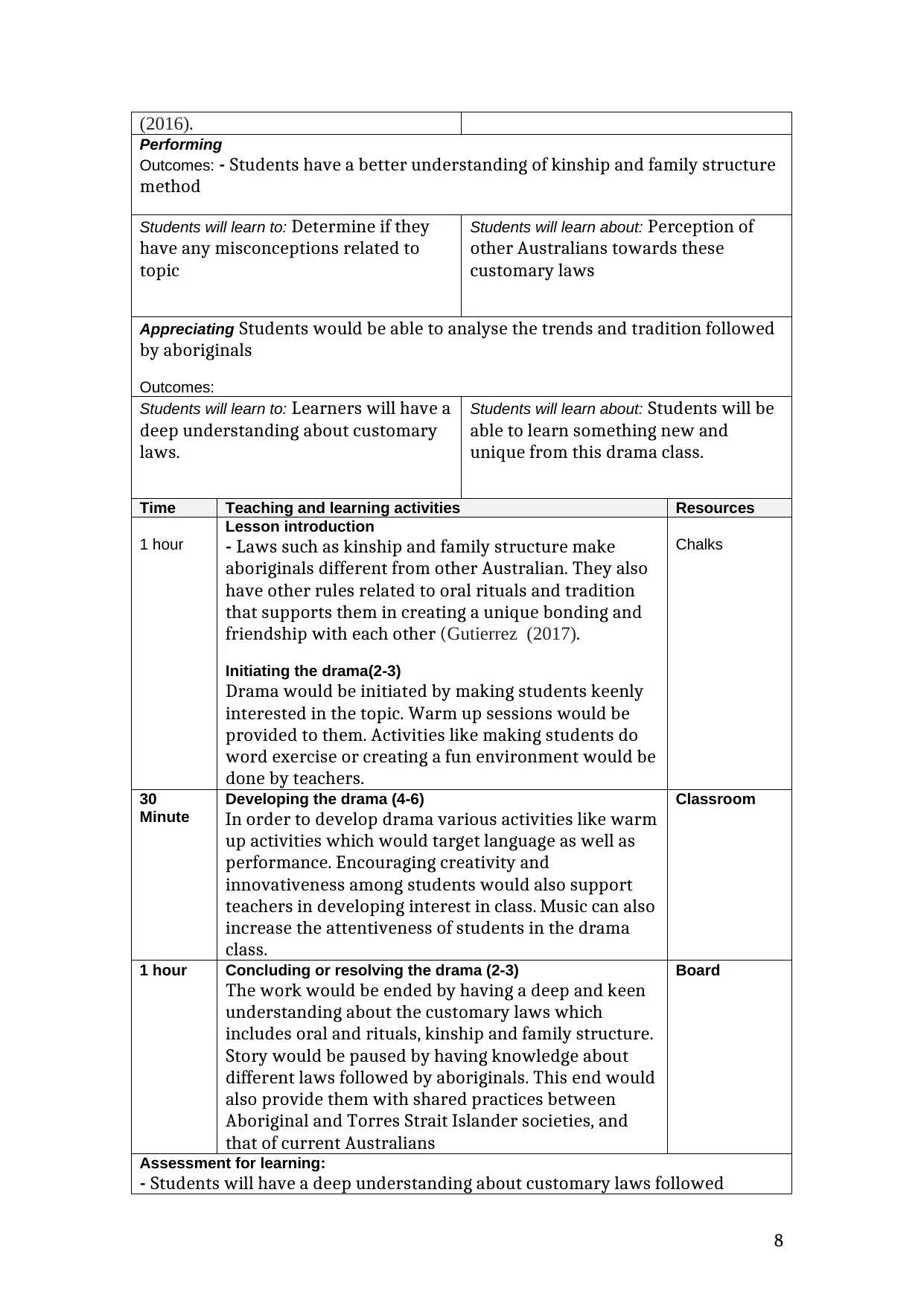
(2016).
Performing
Outcomes: - Students have a better understanding of kinship and family structure
method
Students will learn to: Determine if they
have any misconceptions related to
topic
Students will learn about: Perception of
other Australians towards these
customary laws
Appreciating Students would be able to analyse the trends and tradition followed
by aboriginals
Outcomes:
Students will learn to: Learners will have a
deep understanding about customary
laws.
Students will learn about: Students will be
able to learn something new and
unique from this drama class.
Time Teaching and learning activities Resources
1 hour
Lesson introduction
- Laws such as kinship and family structure make
aboriginals different from other Australian. They also
have other rules related to oral rituals and tradition
that supports them in creating a unique bonding and
friendship with each other (Gutierrez (2017).
Initiating the drama(2-3)
Drama would be initiated by making students keenly
interested in the topic. Warm up sessions would be
provided to them. Activities like making students do
word exercise or creating a fun environment would be
done by teachers.
Chalks
30
Minute
Developing the drama (4-6)
In order to develop drama various activities like warm
up activities which would target language as well as
performance. Encouraging creativity and
innovativeness among students would also support
teachers in developing interest in class. Music can also
increase the attentiveness of students in the drama
class.
Classroom
1 hour Concluding or resolving the drama (2-3)
The work would be ended by having a deep and keen
understanding about the customary laws which
includes oral and rituals, kinship and family structure.
Story would be paused by having knowledge about
different laws followed by aboriginals. This end would
also provide them with shared practices between
Aboriginal and Torres Strait Islander societies, and
that of current Australians
Board
Assessment for learning:
- Students will have a deep understanding about customary laws followed
8
Performing
Outcomes: - Students have a better understanding of kinship and family structure
method
Students will learn to: Determine if they
have any misconceptions related to
topic
Students will learn about: Perception of
other Australians towards these
customary laws
Appreciating Students would be able to analyse the trends and tradition followed
by aboriginals
Outcomes:
Students will learn to: Learners will have a
deep understanding about customary
laws.
Students will learn about: Students will be
able to learn something new and
unique from this drama class.
Time Teaching and learning activities Resources
1 hour
Lesson introduction
- Laws such as kinship and family structure make
aboriginals different from other Australian. They also
have other rules related to oral rituals and tradition
that supports them in creating a unique bonding and
friendship with each other (Gutierrez (2017).
Initiating the drama(2-3)
Drama would be initiated by making students keenly
interested in the topic. Warm up sessions would be
provided to them. Activities like making students do
word exercise or creating a fun environment would be
done by teachers.
Chalks
30
Minute
Developing the drama (4-6)
In order to develop drama various activities like warm
up activities which would target language as well as
performance. Encouraging creativity and
innovativeness among students would also support
teachers in developing interest in class. Music can also
increase the attentiveness of students in the drama
class.
Classroom
1 hour Concluding or resolving the drama (2-3)
The work would be ended by having a deep and keen
understanding about the customary laws which
includes oral and rituals, kinship and family structure.
Story would be paused by having knowledge about
different laws followed by aboriginals. This end would
also provide them with shared practices between
Aboriginal and Torres Strait Islander societies, and
that of current Australians
Board
Assessment for learning:
- Students will have a deep understanding about customary laws followed
8
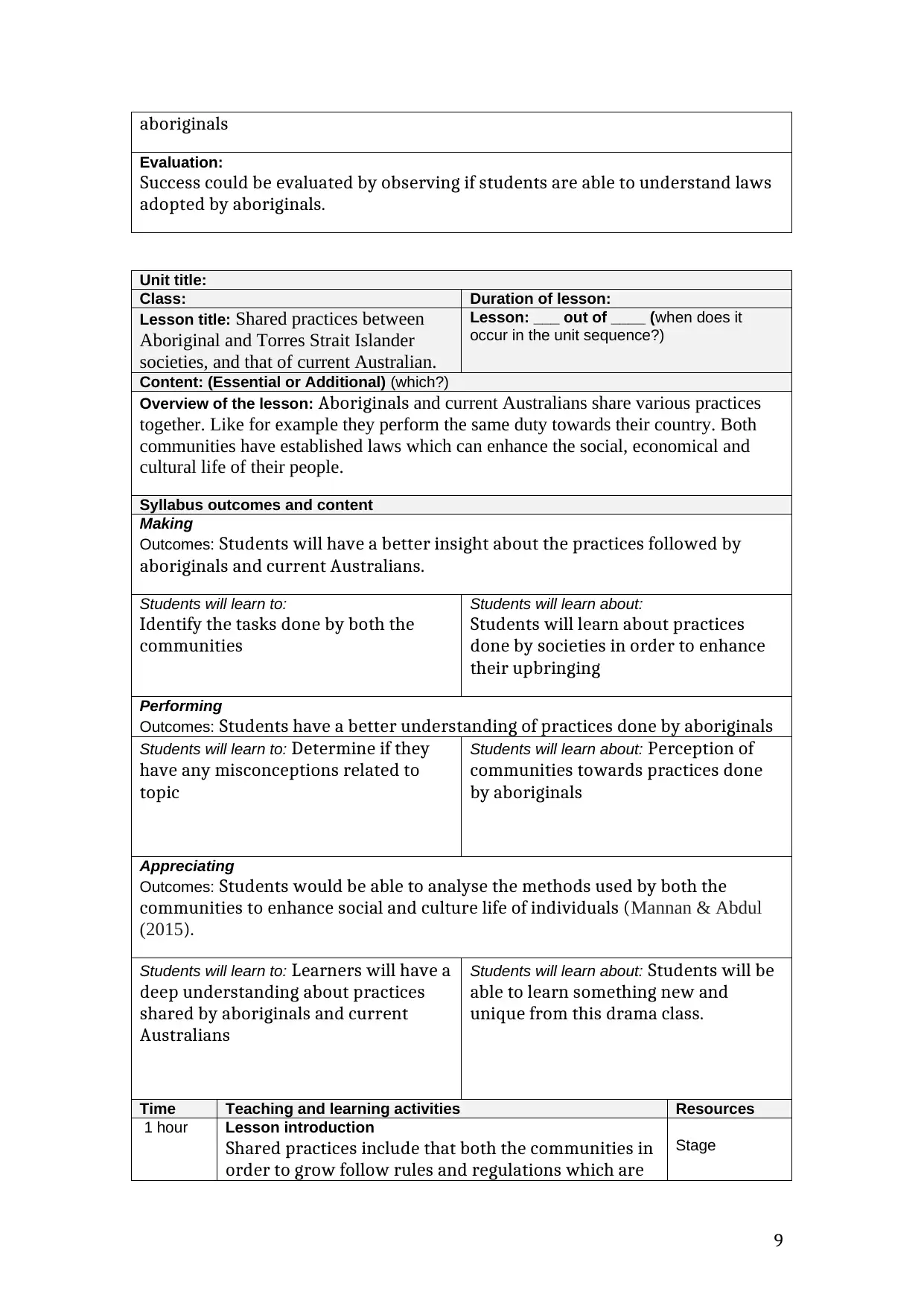
aboriginals
Evaluation:
Success could be evaluated by observing if students are able to understand laws
adopted by aboriginals.
Unit title:
Class: Duration of lesson:
Lesson title: Shared practices between
Aboriginal and Torres Strait Islander
societies, and that of current Australian.
Lesson: ___ out of ____ (when does it
occur in the unit sequence?)
Content: (Essential or Additional) (which?)
Overview of the lesson: Aboriginals and current Australians share various practices
together. Like for example they perform the same duty towards their country. Both
communities have established laws which can enhance the social, economical and
cultural life of their people.
Syllabus outcomes and content
Making
Outcomes: Students will have a better insight about the practices followed by
aboriginals and current Australians.
Students will learn to:
Identify the tasks done by both the
communities
Students will learn about:
Students will learn about practices
done by societies in order to enhance
their upbringing
Performing
Outcomes: Students have a better understanding of practices done by aboriginals
Students will learn to: Determine if they
have any misconceptions related to
topic
Students will learn about: Perception of
communities towards practices done
by aboriginals
Appreciating
Outcomes: Students would be able to analyse the methods used by both the
communities to enhance social and culture life of individuals (Mannan & Abdul
(2015).
Students will learn to: Learners will have a
deep understanding about practices
shared by aboriginals and current
Australians
Students will learn about: Students will be
able to learn something new and
unique from this drama class.
Time Teaching and learning activities Resources
1 hour Lesson introduction
Shared practices include that both the communities in
order to grow follow rules and regulations which are
Stage
9
Evaluation:
Success could be evaluated by observing if students are able to understand laws
adopted by aboriginals.
Unit title:
Class: Duration of lesson:
Lesson title: Shared practices between
Aboriginal and Torres Strait Islander
societies, and that of current Australian.
Lesson: ___ out of ____ (when does it
occur in the unit sequence?)
Content: (Essential or Additional) (which?)
Overview of the lesson: Aboriginals and current Australians share various practices
together. Like for example they perform the same duty towards their country. Both
communities have established laws which can enhance the social, economical and
cultural life of their people.
Syllabus outcomes and content
Making
Outcomes: Students will have a better insight about the practices followed by
aboriginals and current Australians.
Students will learn to:
Identify the tasks done by both the
communities
Students will learn about:
Students will learn about practices
done by societies in order to enhance
their upbringing
Performing
Outcomes: Students have a better understanding of practices done by aboriginals
Students will learn to: Determine if they
have any misconceptions related to
topic
Students will learn about: Perception of
communities towards practices done
by aboriginals
Appreciating
Outcomes: Students would be able to analyse the methods used by both the
communities to enhance social and culture life of individuals (Mannan & Abdul
(2015).
Students will learn to: Learners will have a
deep understanding about practices
shared by aboriginals and current
Australians
Students will learn about: Students will be
able to learn something new and
unique from this drama class.
Time Teaching and learning activities Resources
1 hour Lesson introduction
Shared practices include that both the communities in
order to grow follow rules and regulations which are
Stage
9
⊘ This is a preview!⊘
Do you want full access?
Subscribe today to unlock all pages.

Trusted by 1+ million students worldwide
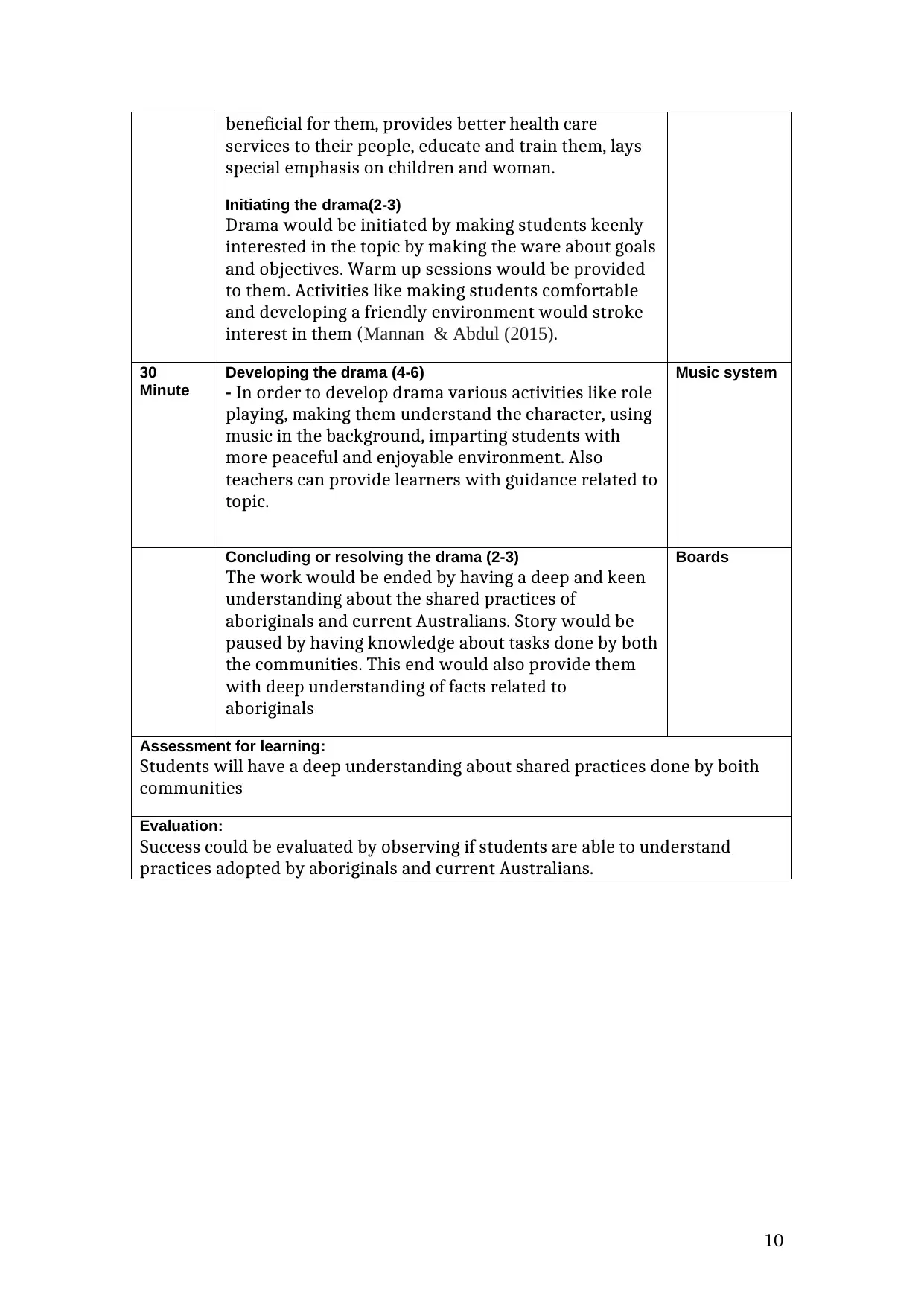
beneficial for them, provides better health care
services to their people, educate and train them, lays
special emphasis on children and woman.
Initiating the drama(2-3)
Drama would be initiated by making students keenly
interested in the topic by making the ware about goals
and objectives. Warm up sessions would be provided
to them. Activities like making students comfortable
and developing a friendly environment would stroke
interest in them (Mannan & Abdul (2015).
30
Minute
Developing the drama (4-6)
- In order to develop drama various activities like role
playing, making them understand the character, using
music in the background, imparting students with
more peaceful and enjoyable environment. Also
teachers can provide learners with guidance related to
topic.
Music system
Concluding or resolving the drama (2-3)
The work would be ended by having a deep and keen
understanding about the shared practices of
aboriginals and current Australians. Story would be
paused by having knowledge about tasks done by both
the communities. This end would also provide them
with deep understanding of facts related to
aboriginals
Boards
Assessment for learning:
Students will have a deep understanding about shared practices done by boith
communities
Evaluation:
Success could be evaluated by observing if students are able to understand
practices adopted by aboriginals and current Australians.
10
services to their people, educate and train them, lays
special emphasis on children and woman.
Initiating the drama(2-3)
Drama would be initiated by making students keenly
interested in the topic by making the ware about goals
and objectives. Warm up sessions would be provided
to them. Activities like making students comfortable
and developing a friendly environment would stroke
interest in them (Mannan & Abdul (2015).
30
Minute
Developing the drama (4-6)
- In order to develop drama various activities like role
playing, making them understand the character, using
music in the background, imparting students with
more peaceful and enjoyable environment. Also
teachers can provide learners with guidance related to
topic.
Music system
Concluding or resolving the drama (2-3)
The work would be ended by having a deep and keen
understanding about the shared practices of
aboriginals and current Australians. Story would be
paused by having knowledge about tasks done by both
the communities. This end would also provide them
with deep understanding of facts related to
aboriginals
Boards
Assessment for learning:
Students will have a deep understanding about shared practices done by boith
communities
Evaluation:
Success could be evaluated by observing if students are able to understand
practices adopted by aboriginals and current Australians.
10
Paraphrase This Document
Need a fresh take? Get an instant paraphrase of this document with our AI Paraphraser
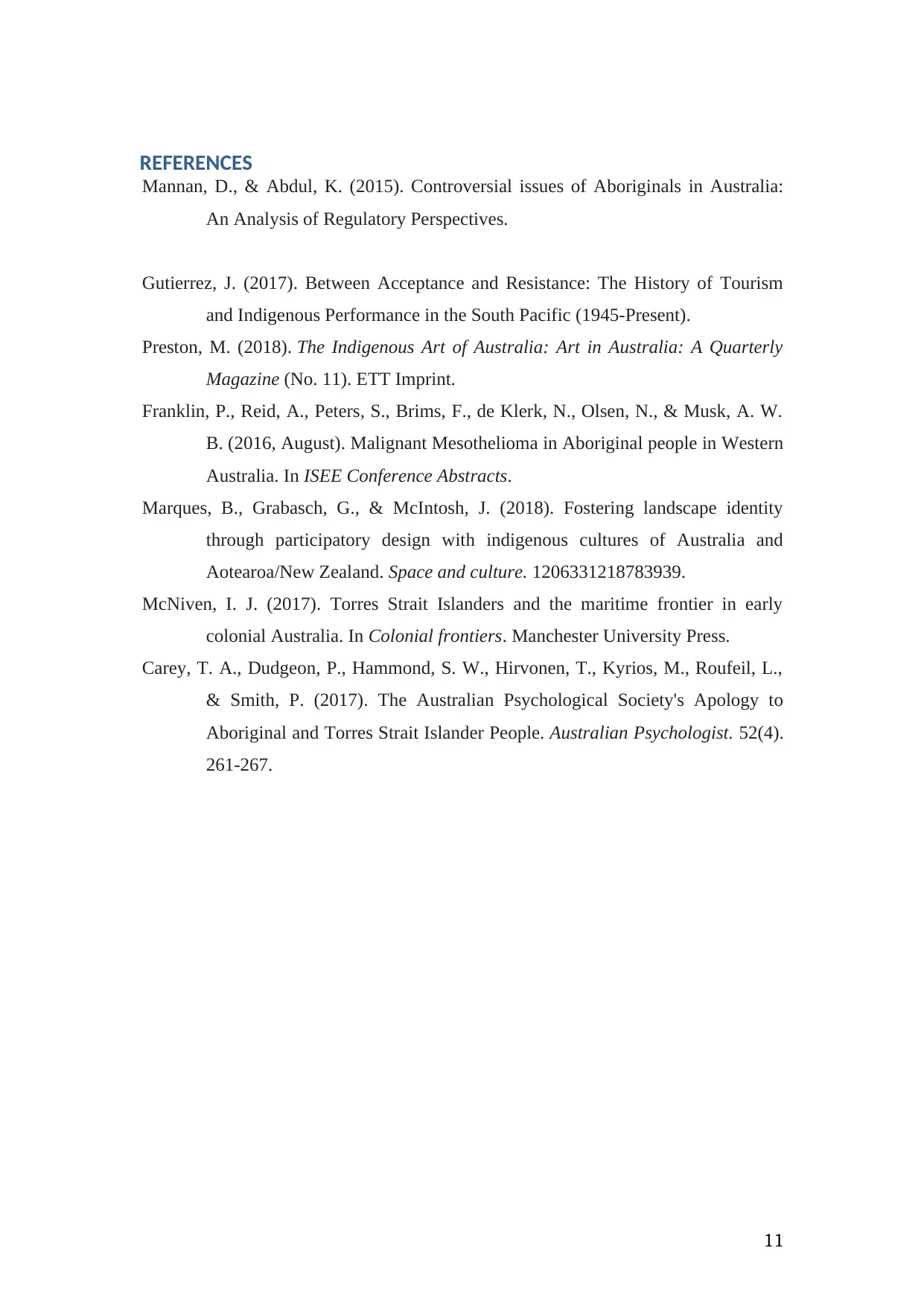
REFERENCES
Mannan, D., & Abdul, K. (2015). Controversial issues of Aboriginals in Australia:
An Analysis of Regulatory Perspectives.
Gutierrez, J. (2017). Between Acceptance and Resistance: The History of Tourism
and Indigenous Performance in the South Pacific (1945-Present).
Preston, M. (2018). The Indigenous Art of Australia: Art in Australia: A Quarterly
Magazine (No. 11). ETT Imprint.
Franklin, P., Reid, A., Peters, S., Brims, F., de Klerk, N., Olsen, N., & Musk, A. W.
B. (2016, August). Malignant Mesothelioma in Aboriginal people in Western
Australia. In ISEE Conference Abstracts.
Marques, B., Grabasch, G., & McIntosh, J. (2018). Fostering landscape identity
through participatory design with indigenous cultures of Australia and
Aotearoa/New Zealand. Space and culture. 1206331218783939.
McNiven, I. J. (2017). Torres Strait Islanders and the maritime frontier in early
colonial Australia. In Colonial frontiers. Manchester University Press.
Carey, T. A., Dudgeon, P., Hammond, S. W., Hirvonen, T., Kyrios, M., Roufeil, L.,
& Smith, P. (2017). The Australian Psychological Society's Apology to
Aboriginal and Torres Strait Islander People. Australian Psychologist. 52(4).
261-267.
11
Mannan, D., & Abdul, K. (2015). Controversial issues of Aboriginals in Australia:
An Analysis of Regulatory Perspectives.
Gutierrez, J. (2017). Between Acceptance and Resistance: The History of Tourism
and Indigenous Performance in the South Pacific (1945-Present).
Preston, M. (2018). The Indigenous Art of Australia: Art in Australia: A Quarterly
Magazine (No. 11). ETT Imprint.
Franklin, P., Reid, A., Peters, S., Brims, F., de Klerk, N., Olsen, N., & Musk, A. W.
B. (2016, August). Malignant Mesothelioma in Aboriginal people in Western
Australia. In ISEE Conference Abstracts.
Marques, B., Grabasch, G., & McIntosh, J. (2018). Fostering landscape identity
through participatory design with indigenous cultures of Australia and
Aotearoa/New Zealand. Space and culture. 1206331218783939.
McNiven, I. J. (2017). Torres Strait Islanders and the maritime frontier in early
colonial Australia. In Colonial frontiers. Manchester University Press.
Carey, T. A., Dudgeon, P., Hammond, S. W., Hirvonen, T., Kyrios, M., Roufeil, L.,
& Smith, P. (2017). The Australian Psychological Society's Apology to
Aboriginal and Torres Strait Islander People. Australian Psychologist. 52(4).
261-267.
11
1 out of 11
Related Documents
Your All-in-One AI-Powered Toolkit for Academic Success.
+13062052269
info@desklib.com
Available 24*7 on WhatsApp / Email
![[object Object]](/_next/static/media/star-bottom.7253800d.svg)
Unlock your academic potential
Copyright © 2020–2025 A2Z Services. All Rights Reserved. Developed and managed by ZUCOL.





